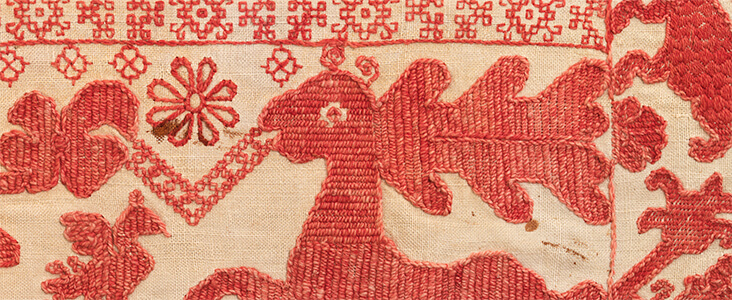1. Japanese Sashiko
The Art of Sashiko Embroidery
Sashiko, meaning “little stabs” in Japanese, originated in rural Japan as a practical way to reinforce clothing. Traditionally, it involved simple running stitches to create geometric patterns, often on indigo-dyed fabric.
Significance and Techniques
Sashiko is not only functional but also aesthetic. It represents the Japanese ethos of simplicity and beauty in everyday life. Common designs include waves, mountains, and asanoha (hemp leaf), showcasing nature’s influence. The technique emphasizes even stitching and careful planning of patterns, resulting in stunning visual effects.
2. Indian Kantha
Rich Heritage of Kantha Stitching
Kantha embroidery hails from Bengal, India, and is known for its unique, colorful patterns. It originally involved stitching together layers of old saris to create quilts, giving them new life.
Patterns and Symbolism
Kantha patterns often feature motifs from nature, such as flowers, birds, and animals, reflecting the region’s vibrant culture. The stitches are typically simple running stitches, but the combination of colors and designs creates intricate visual storytelling. Kantha embodies a deep connection to heritage, as each piece often carries stories from the past.
3. Mexican Otomi Embroidery
Vibrant Colors of Otomi Embroidery
Otomi embroidery, known for its vivid colors and intricate designs, originates from the Otomi people in Mexico. This folk art is characterized by bold, nature-inspired motifs.
Motifs and Craftsmanship
Common Otomi designs include animals, plants, and geometric shapes, often arranged in symmetrical patterns. The embroidery is typically done on white cotton fabric using brightly colored threads, showcasing the artistry and craftsmanship of the Otomi community. The patterns not only reflect the region’s biodiversity but also the cultural significance of each motif.
4. Romanian Traditional Embroidery

Intricate Designs of Romanian Embroidery
Romanian traditional embroidery is rich in history, often seen on folk costumes known as “ia.” The patterns are distinctive and feature a mix of geometric shapes and floral designs.
Stitches and Cultural Significance
Embroidery in Romania is typically done using cross-stitch, satin stitch, and other decorative stitches. The colors used in the embroidery often symbolize various meanings, with red representing love, black representing mourning, and green symbolizing hope. These embroidered garments play a vital role in cultural celebrations and family traditions.
5. Turkish Redwork
Traditional Redwork Patterns in Turkey
Redwork, primarily found in Turkish embroidery, is characterized by its striking red thread on white or cream fabric. It features a variety of motifs, including floral and geometric patterns. https://www.industrialandsafetywarehouse.com.au/
History and Techniques
Originally, redwork was used for household items like tablecloths and bed linens, representing both utility and beauty. The technique involves using simple backstitch and outline stitch, allowing for clean, sharp designs. Redwork continues to be a symbol of Turkish craftsmanship and is often used in traditional celebrations and weddings.
6. African Kente Cloth Embroidery
The Rich Tapestry of Kente Embroidery
Kente cloth, originating from the Ashanti people of Ghana, is a vibrant and colorful fabric often adorned with intricate embroidery. Each Kente pattern carries specific meanings and is deeply rooted in cultural identity.
Symbolism and Techniques
Kente patterns are often made up of bright colors and geometric shapes, each representing different proverbs, historical events, or moral values. The embroidery techniques used enhance the beauty of the fabric, adding texture and depth. Kente cloth is often worn during significant events, symbolizing pride and heritage.
7. Russian Chinoiserie Embroidery
Exquisite Details of Chinoiserie Embroidery
Chinoiserie, a term used to describe European interpretations of Chinese and East Asian styles, is reflected in Russian embroidery. This style often features intricate floral designs and landscapes, influenced by the 18th-century fascination with Asian aesthetics.
Techniques and Cultural Influences
The embroidery is characterized by delicate stitching and the use of metallic threads. Common motifs include peacocks, flowers, and other natural elements, showcasing the fusion of Russian and Asian cultures. Chinoiserie embroidery is a testament to the rich exchange of artistic ideas throughout history.
8. Scottish Cross Stitch
Traditional Cross Stitch Patterns of Scotland
Scottish cross stitch embroidery is known for its intricate designs and historical significance. Often featured in traditional garments, these patterns tell stories of Scottish heritage and culture.
Common Motifs and Techniques
Common motifs in Scottish cross stitch include thistles, flowers, and tartan patterns. The embroidery is typically executed using bright colors on linen fabric, showcasing the region’s rich textile tradition. Cross stitch techniques emphasize precision and attention to detail, making each piece a unique representation of Scottish artistry.
9. Peruvian Huayruro Embroidery
The Cultural Significance of Huayruro Patterns
Huayruro embroidery, originating from the Andean regions of Peru, is characterized by vibrant colors and symbolic motifs. This style is often used to adorn clothing and textiles.
Patterns and Symbolism
The Huayruro seed, a symbol of good luck and protection, is often depicted in embroidery patterns. The use of bright red and black threads creates striking contrasts, reflecting the natural beauty of the Andes. The craftsmanship involved in Huayruro embroidery showcases the deep connection between the people and their environment.
10. Thai Lanna Embroidery
The Art of Lanna Embroidery in Thailand
Lanna embroidery, from the northern regions of Thailand, is known for its intricate patterns and vibrant colors. It is commonly found in traditional clothing and decorative items.
Techniques and Cultural Context
Lanna embroidery incorporates techniques such as satin stitch and cross-stitch, often depicting motifs inspired by nature, such as lotus flowers and mythical creatures. This style reflects the rich cultural heritage of the Lanna people and their connection to the land.
Conclusion
Traditional embroidery patterns worldwide showcase the rich cultural diversity and artistic heritage of various regions. Each pattern tells a unique story, connecting us to the past and enriching our understanding of different cultures. By exploring these traditional embroidery patterns worldwide, we not only celebrate the artistry involved but also honor the history and significance behind each stitch. Whether you’re an embroiderer or simply an admirer of this beautiful art form, there’s always something new to discover in the world of traditional embroidery.
